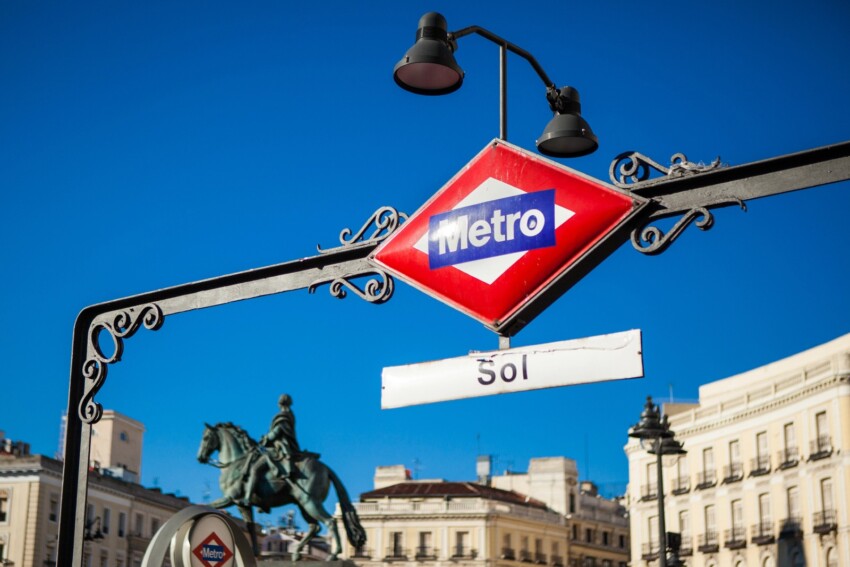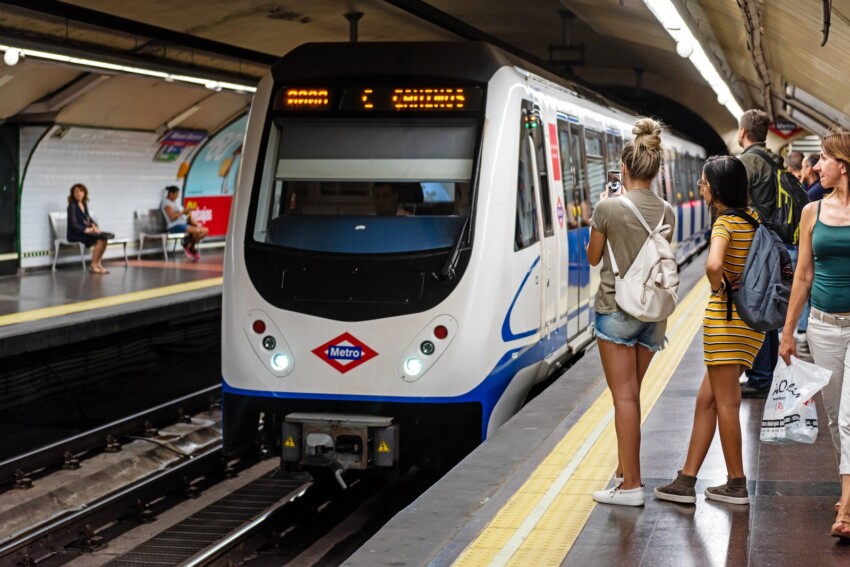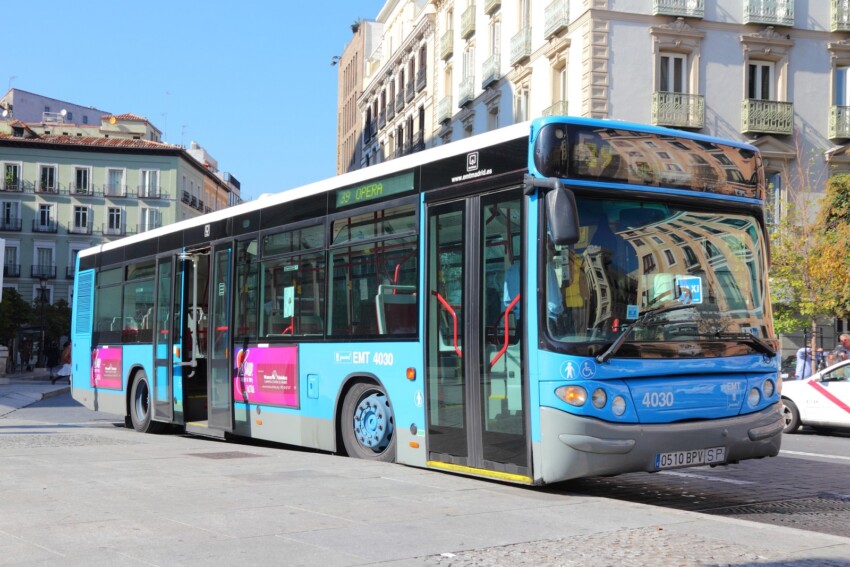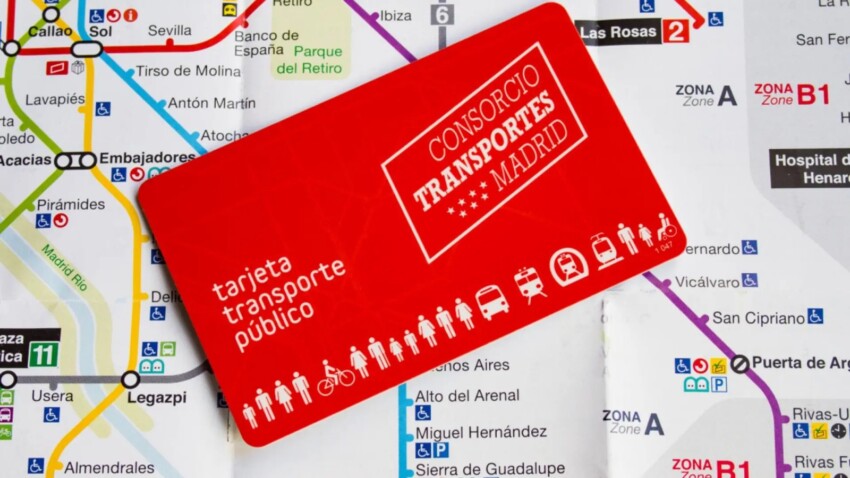

Madrid is a huge metropolis: even the most hardened walkers will not be able to avoid using public transport at least a few times during their holiday.
Thanks to an extensive public transport network that includes buses, metro, metrobuses and regional trains, it is possible to move quickly from one point to another in Madrid and from the city to neighbouring municipalities. Public transport in Madrid is efficient and inexpensive and operates both day and night.
If you want more comfort, you can opt for the tourist buses, which, with their routes designed for people on holiday in Madrid, allow you to explore the capital in total freedom, without the stress of figuring out which means of transport to take and where; if you like to be active, you can take advantage of the public bike rental network.
Below you will find all the useful information on transport, tickets and passes to plan your trips in Madrid.
The tourist buses, usually operated by private companies, are by far the most convenient way to visit the city of Madrid if you have little time.
Here, as in all big cities, you can travel on Hop On Hop Off buses that follow a tourist route within the capital, with stops near the main tourist attractions.
You can start the route wherever you like, get off wherever you like and get back on as many times as you like: there is no limit to the use you can make of these buses during the period of validity of your ticket!
You can choose to buy a one-day or two-day ticket; included in the ticket is an audio guide with tourist information in several languages.

The metro is definitely the most effective way to move quickly in a huge city like Madrid: it is perfect to get around the centre, but also to reach the airport, the fairground, the main commercial areas, the suburbs and even some neighbouring cities in no time at all.
Madrid’s metro network, one of the most extensive in Europe, comprises twelve metro lines, three metrobuses (in Spanish ‘metro ligero’) and the Ramal, a line connecting the stations of Ópera and Príncipe Pío.
The metro generally runs from 6 a.m. until 1.30 p.m. The frequency of trains on weekdays ranges from one every two minutes at peak hours to one every fifteen minutes in the last hour and a half of service; on public holidays waiting times for the metro increase.
Here are all the Madrid metro lines in detail:

Madrid’s urban bus network, managed by the Empresa Municipal de Transportes (EMT), is no less extensive and efficient than that of the metro: suffice it to say that there are more than 2,000 buses that ply the streets of the capital on a daily basis.
As in all cities, buses in Madrid are subject to traffic delays, which is why many Madrileños and tourists prefer to use the metro, but there are a couple of advantages to travelling by bus.
Firstly, the buses arrive in areas not covered by the metro and secondly, travelling by bus gives you the chance to look out of the window and enjoy the city.
Most buses operate from 6 a.m. to 11.30 p.m., with a waiting time for a bus ranging from 4 to 15 minutes depending on the line and time slot; on holidays the service hours are reduced, from 7 a.m. to 11 p.m.
Madrid is a city that never sleeps and even the buses are no exception: at night the búhos (night buses) operate 26 different routes, all leaving from Cibeles Square.
On weekdays the búhos operate from 11.55 p.m. to 4 a.m., with a bus every 35 minutes; on Saturdays and public holidays they operate from 11 p.m. to 7 a.m., with a bus every 15 to 20 minutes.
Another way to get to Madrid-Barajas airport besides the metro is by Exprés del aeropuerto, the direct bus that connects the city centre with terminals T1, T2 and T4 of the airport. The bus operates 24 hours a day and can therefore also be used at night, when the metro has stopped running.
The approximate journey time is 30-40 minutes, but may vary depending on traffic; the bus frequency is one every 15-20 minutes during daytime hours and 35 at night.
The bus ticket to the airport is bought exclusively from the driver: individual city bus tickets are not valid.
The regional trains of the Cercanías network are the cheapest and fastest way to travel from the centre of Madrid to the surrounding municipalities and, given the large number of stations in the city, are also a good way to travel within the capital.
They are mainly used by tourists for day trips. Places you can easily reach with Cercanías trains are El Escorial, the Sierra de Guadarrama and Aranjuez. In total, the Cercanías network comprises 10 lines.
Regional trains run from five to six in the morning (depending on the line) until midnight, with a frequency of between 10 and 30 minutes. Ticket prices vary depending on the area within which you are travelling.
Buying single tickets is only recommended for those who plan to make limited use of public transport, for example if your hotel is located in the centre and you plan to focus your holiday on the attractions in the area.
Single ticket prices in Madrid are:
One-way metro tickets can be purchased at ticket machines inside metro stations, while single bus tickets can be bought directly from the driver.

If you plan to use public transport several times a day, it is worth buying a season ticket instead of single tickets. In addition to personal season tickets, which are suitable for residents, there are also season tickets designed for the needs of tourists.
The tourist season ticket allows unlimited use of public transport in the Community of Madrid for the period of validity of the season ticket: it exists in 1, 2, 3, 5 and 7-day versions for zone A only or for the entire network (zone T).
The tourist season ticket valid for zone A includes
The tourist season ticket for zone T includes
The price of the Madrid tourist season ticket varies according to the duration chosen and the zone. For zone A, prices range from a minimum of 8.40 euros for one day to a maximum of 35.40 for 7 days, while for zone T they range from 17.00 euros to 70.80.
There is a 50% discount for children up to the age of 11, while children up to the age of 4 travel free of charge.
The tourist season ticket can be purchased at Madrid-Barajas airport at the tourist information offices, in the metro stations and at the Madrid Regional Transport Consortium headquarters in Plaza de Descubridor Diego de Ordás.
You can buy carnets of 10 tickets for the metro, bus, metrobus or a combination of these means. Tickets are valid on any day of the week for any line in the area indicated on the ticket.
The cost of the 10-trip season ticket for zone A (metro, ETM bus and metrobus ML1) is €12.20.
Tarjeta Multi is the smart card for public transport in Madrid: like London’s Oyster and many other public transport cards now widespread throughout the world, it is a rechargeable card on which you can insert credit valid for travel tickets. With each journey made, the corresponding amount will be deducted from your card.
These cards are convenient because thanks to them you do not have to buy a ticket every time you travel; they also save on the cost of individual tickets. Another advantage of the Madrid tarjeta Multi is that it can be used by several people at the same time.
Among the tickets that can be loaded onto the Madrid tarjeta Multi is a tourist season ticket; if the first ticket loaded is a tourist season ticket, the cost of the card is free of charge (it is usually €2.50).
The tarjeta Multi can be purchased at metro ticket machines and authorised retailers.
Which season ticket is most convenient?
To choose the most convenient season ticket, you should already have an idea of how much and how you plan to use public transport. Usually the tourist season ticket or the 10-ride carnet for zone A are the preferred options for tourists.
Consider that tourists generally do not venture outside zone A, unless their hotel is located outside the centre.
Don’t want to know about buses and the metro? Do you prefer more comfort or on the contrary do you want to be more active during your holiday in Madrid? Taxis and bicycles are the solutions for you!
With more than 15,000 taxis covering the city at all hours of the day and night Madrid will never leave you stranded!
Taxis in Madrid are white with a red stripe: you can stop one on the street by raising your arm or take one in the taxi ranks marked with a blue ‘T’ sign.
A fun and environmentally friendly way to get around Madrid is by bicycle, which allows you to enjoy the outdoors and avoid getting stuck in traffic.
You can rent an electric bike very cheaply at one of the 165 stations of the BiciMAD network: in addition to annual passes for residents, there are 1-, 3- or 5-day passes for tourists.
There are many stations in the city centre and some are at famous tourist attractions, such as Paseo del Prado, Puerta del Sol, Mercado de San Miguel, Plaza de Cibeles and many more…
City Card allow you to save on public transport and / or on the entrances to the main tourist attractions.
